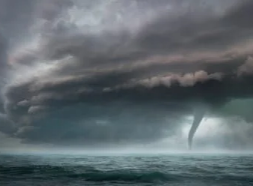Climate Disasters / Emergencies

Climate disasters are sudden or slow-onset events that result from the interaction between natural hazards and exposed, vulnerable populations. These include floods, wildfires, hurricanes, droughts, and extreme heat. Scientific consensus now strongly affirms that climate change is increasing the intensity, frequency, and unpredictability of these disasters—transforming them into widespread humanitarian and environmental emergencies.¹
Climate Signals in Disasters
Climate change amplifies weather extremes in multiple ways. For instance:
• Rising ocean temperatures provide more energy to tropical cyclones, making hurricanes more intense.
• A warmer atmosphere holds more moisture, leading to heavier rainfall and flash floods.
• Prolonged droughts desiccate landscapes, turning forests and grasslands into tinderboxes.
• Melting glaciers and sea-level rise exacerbate the impacts of coastal storms and tidal floods.
These changes do not act in isolation; they interact and compound, often overwhelming emergency systems and infrastructure.²
Statistical Trends
The data is stark:
- Since 1980, the number of climate-related disasters has tripled.
- In 2023, the world experienced over 300 weather-related disasters, from record heatwaves in Europe to historic floods in Libya.³
- Losses from such events are rising: economic damages now average over $300 billion per year globally, with a growing share attributed to climate extremes.⁴
Four Categories of Climate-Linked Disasters
| Type | Climate Trigger | Example (Recent) |
| Floods | Heavy rainfall, glacial melt, sea-level rise | 2022 Pakistan floods displaced 33 million⁵ |
| Wildfires | Prolonged heatwaves, low humidity | 2023 Canada wildfire season, record 18M ha burned⁶ |
| Storms | Warmer oceans, shifting wind patterns | Cyclone Mocha (2023) impacted Bangladesh⁷ |
| Heatwaves | Global temperature increase | 2023 China/Europe heatwaves exceeded 45°C⁸ |
These events can also trigger secondary crises such as disease outbreaks (e.g. cholera post-flood), food insecurity, and forced migration.
Human Impact and Inequality
Disasters disproportionately affect vulnerable populations. Those in informal housing, with low incomes, or living in rural/coastal areas are more likely to lose homes, livelihoods, and access to healthcare. Children and the elderly suffer higher mortality during heatwaves and floods. Despite contributing least to global emissions, developing nations face the greatest human toll.⁹
Moreover, low-preparedness regions often lack early warning systems or disaster insurance, meaning the same event can devastate one population while another remains largely protected.¹⁰
Early Warning and Risk Reduction
Recognizing the urgency, the UN launched the "Early Warnings for All" initiative in 2022. Its goal: ensure every person on Earth receives timely alerts for weather hazards by 2027. This includes investments in radar systems, data modeling, community communication, and public education.¹¹
Countries like Japan and Bangladesh demonstrate that early action and preparedness can save lives, even in high-risk areas. Their systems combine public alerts, emergency drills, shelter networks, and local knowledge.¹²
Conclusion
Climate change is not only a future threat—it is already reshaping the disaster landscape. More intense storms, fires, floods, and droughts are a clear warning. Only through integrated planning, climate adaptation, and strengthened early warning systems can societies reduce these impacts.
Footnotes
- UNDRR. (2022). Human Cost of Disasters 2000–2021. https://www.undrr.org
- NASA Earth Observatory. (2023). Climate and Extreme Weather. https://earthobservatory.nasa.gov
- WMO. (2024). State of the Global Climate 2023. https://library.wmo.int
- Swiss Re Institute. (2023). Natural Catastrophes Report. https://www.swissre.com
- UN OCHA. (2022). Pakistan Floods Situation Report. https://www.unocha.org
- Canadian Interagency Forest Fire Centre. (2023). National Wildfire Statistics. https://www.ciffc.ca
- ReliefWeb. (2023). Cyclone Mocha Situation Update. https://reliefweb.int
- Copernicus Climate Change Service. (2023). European Heatwaves. https://climate.copernicus.eu
- UNFCCC. (2023). Climate Justice and Equity. https://unfccc.int
- IFRC. (2021). World Disasters Report: Inequality in Risk. https://www.ifrc.org
- United Nations. (2022). Early Warnings for All. https://www.un.org
- UNDP. (2021). Disaster Risk Management Case Studies. https://www.undp.org
Photo: Pixabay licenced via SITE123